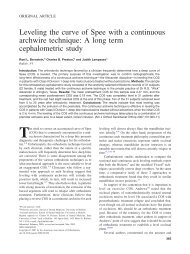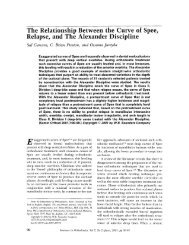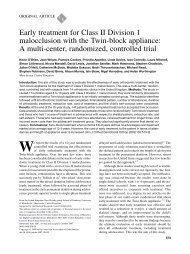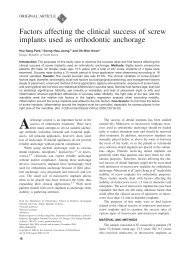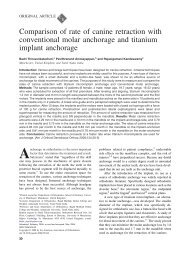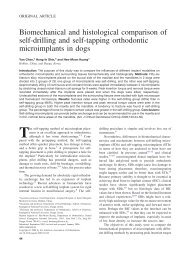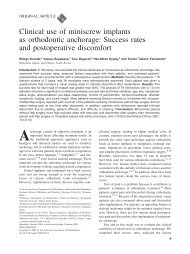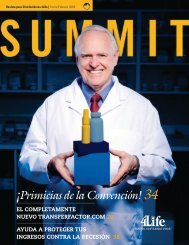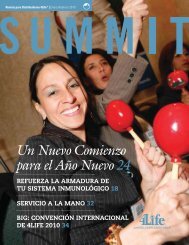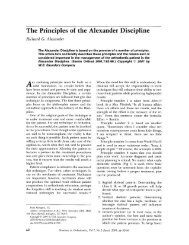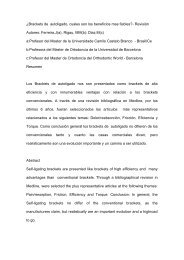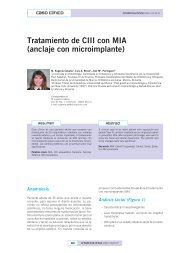Torque expression of self-ligating brackets compared with ...
Torque expression of self-ligating brackets compared with ...
Torque expression of self-ligating brackets compared with ...
Create successful ePaper yourself
Turn your PDF publications into a flip-book with our unique Google optimized e-Paper software.
European Journal <strong>of</strong> Orthodontics 30 (2008) 233–238 © The Author 2008. Published by Oxford University Press on behalf <strong>of</strong> the European Orthodontic Society.<br />
doi:10.1093/ejo/cjn005<br />
All rights reserved. For permissions, please email: journals.permissions@oxfordjournals.org.<br />
<strong>Torque</strong> <strong>expression</strong> <strong>of</strong> <strong>self</strong>-<strong>ligating</strong> <strong>brackets</strong> <strong>compared</strong> <strong>with</strong><br />
conventional metallic, ceramic, and plastic <strong>brackets</strong><br />
Enver Morina * , ** , Theodore Eliades *** , Nikolaos Pandis **** , Andreas Jäger ** and<br />
Christoph Bourauel *<br />
Departments <strong>of</strong> * Oral Technology , and ** Orthodontics, School <strong>of</strong> Dentistry, University <strong>of</strong> Bonn, Germany ,<br />
*** Department <strong>of</strong> Orthodontics, School <strong>of</strong> Dentistry, Aristotle University <strong>of</strong> Thessaloniki, Greece and **** Private<br />
Orthodontic Practice, Corfu, Greece<br />
SUMMARY The purpose <strong>of</strong> this research was to investigate the torque capacity <strong>of</strong> active and passive <strong>self</strong><strong>ligating</strong><br />
<strong>brackets</strong> <strong>compared</strong> <strong>with</strong> metallic, ceramic, and polycarbonate edgewise <strong>brackets</strong>. Six types <strong>of</strong><br />
orthodontic <strong>brackets</strong> were included in the study: the <strong>self</strong>-<strong>ligating</strong> Speed and Damon2, the stainless steel<br />
(SS), Ultratrimm and Discovery, the ceramic bracket, Fascination 2, and the polycarbonate bracket, Brillant.<br />
All <strong>brackets</strong> had a 0.022-inch slot size and were torqued <strong>with</strong> 0.019 × 0.025-inch SS archwires. For this<br />
purpose, the labial crown torque <strong>of</strong> an upper central incisor was measured in a simulated intraoral clinical<br />
situation using the orthodontic measurement and simulation system (OMSS). A torque <strong>of</strong> 20 degrees<br />
was applied and the correction <strong>of</strong> the misalignement was simulated experimentally <strong>with</strong> the OMSS. Each<br />
bracket/wire combination was measured fi ve times. Maximum torquing moments and torque loss were<br />
determined. The results were analysed <strong>with</strong> one-way analysis <strong>of</strong> variance, <strong>with</strong> the bracket serving as the<br />
sole discriminating variable, and the Tukey test at the 0.05 level <strong>of</strong> signifi cance.<br />
The ceramic bracket (Fascination 2) presented the highest torquing moment (35 Nmm) and, together<br />
<strong>with</strong> a SS bracket, the lowest torque loss (4.6 degrees). Self-<strong>ligating</strong>, polycarbonate, and selective metallic<br />
<strong>brackets</strong> demonstrated almost a 7-fold decreased moment developed during insertion <strong>of</strong> a 0.019 × 0.022inch<br />
SS wire into a 0.022-inch slot and a 100 per cent increase in loss.<br />
Introduction<br />
In orthodontics, torque is employed to alter the inclination<br />
<strong>of</strong> all teeth, particularly the incisors. In general, the extent<br />
<strong>of</strong> change in the buccolingual inclination <strong>of</strong> the crowns<br />
depends on the wire torque stiffness, bracket design, the<br />
wire/slot play, and the mode <strong>of</strong> ligation. The wide array <strong>of</strong><br />
combinations <strong>of</strong> altering factors in defi ning torquing<br />
moments make the empirical clinical determination <strong>of</strong> the<br />
appropriate torquing method a diffi cult task for the practising<br />
pr<strong>of</strong>essional.<br />
Rauch (1959) described torque as ‘ a moment generated<br />
by the torsion <strong>of</strong> a rectangular wire in the bracket slot ’ .<br />
Depending on the amount <strong>of</strong> torsion, the size and quality <strong>of</strong><br />
the wire, the play <strong>of</strong> the wire in the bracket slot, the<br />
angulation, and the deformability <strong>of</strong> the bracket, the<br />
archwire moves the root in a buccal or lingual direction due<br />
to the torsional load induced. The literature lists effective<br />
values for torquing moment in the range <strong>of</strong> 1.0 – 2.0 Ncm<br />
( Burstone, 1966 ; Bantleon and Droschl, 1988 ; Feldner<br />
et al. , 1994 ), whereas minimum values <strong>of</strong> 0.5 Ncm have<br />
been reported for torquing a maxillary central incisor<br />
( Morrow, 1978 ; Holt et al. , 1991 ).<br />
Currently, there is a lack <strong>of</strong> evidence on the torque<br />
characteristics <strong>of</strong> various bracket – archwire combinations<br />
( Dobrin et al. , 1975 ; Germane et al. , 1989 ; Alkire et al. ,<br />
1997 ; Harzer et al. , 2004 ). This may be attributed to the<br />
complexity <strong>of</strong> the experimental confi guration required in<br />
laboratory studies and the multiplicity <strong>of</strong> factors needed to<br />
be controlled in a clinical setting, including individual<br />
response to moments applied, variability in malocclusion,<br />
and the potential effect <strong>of</strong> other auxiliaries or treatment<br />
utilities affecting torque.<br />
In the course <strong>of</strong> orthodontic tooth movement, the amount<br />
<strong>of</strong> activation, i.e. the elastic deformation <strong>of</strong> the torquing<br />
wire and consequently the force system, will vary<br />
signifi cantly due to changes in bracket position ( Drescher<br />
et al. , 1991 ; Bourauel et al. , 1992 ). Therefore, static<br />
determination <strong>of</strong> the torquing moment precludes a reliable<br />
estimation <strong>of</strong> bracket – archwire combinations, while a<br />
dynamic assessment is complex, requiring advanced<br />
experimental instrumentation.<br />
Recently, the introduction <strong>of</strong> active and passive <strong>self</strong><strong>ligating</strong><br />
<strong>brackets</strong> have presented a challenge to the pr<strong>of</strong>ession<br />
because <strong>of</strong> the novel ligation mode and the potential<br />
alterations in the load and moment <strong>expression</strong> during<br />
mechanotherapy. Whereas some <strong>of</strong> these systems seem to<br />
present reduced friction in vitro , their torquing characteristics<br />
remain unknown. The latter may be lower relative to their<br />
standard edgewise counterparts, since torque requires the<br />
development <strong>of</strong> friction between the edges <strong>of</strong> the activated<br />
archwire and the bracket slot walls, to facilitate buccolingual<br />
inclination.<br />
It was the aim <strong>of</strong> this study to experimentally investigate<br />
the torque characteristics <strong>of</strong> different <strong>brackets</strong> <strong>with</strong> respect
234<br />
to varying ligation mechanisms, design, and material<br />
composition.<br />
Materials and methods<br />
Six brands <strong>of</strong> orthodontic <strong>brackets</strong> were included in the<br />
study ( Figure 1 ): the <strong>self</strong>-<strong>ligating</strong> Hanson Speed (Strite<br />
Industries, Cambridge, Ontario, Canada) and Damon 2<br />
(Ormco, Glendora, California, USA), as well as the steel<strong>brackets</strong>,<br />
Ultratrimm® and Discovery® (Dentaurum,<br />
Pforzheim, Germany), the ceramic bracket Fascination® 2<br />
(Dentaurum), and the polycarbonate bracket Brillant®<br />
(Forestadent, Pforzheim, Germany). All <strong>brackets</strong> were <strong>of</strong><br />
0.022-inch slot size and were torqued <strong>with</strong> 0.019 × 0.025inch<br />
stainless steel (SS) archwires (Dentaurum). The effect<br />
<strong>of</strong> the wires on the bonded buccolingual inclination <strong>of</strong> a<br />
maxillary central incisor was simulated using the orthodontic<br />
measurement and simulation system (OMSS). The major<br />
components <strong>of</strong> the OMSS are two force – moment sensors<br />
capable <strong>of</strong> measuring forces and moments simultaneously<br />
E. MORINA ET AL.<br />
in all three planes <strong>of</strong> space ( Figure 2 ). The two sensors are<br />
mounted on motor-driven positioning tables <strong>with</strong> full threedimensional<br />
mobility, whereas all mechanical components<br />
are built in a temperature-controlled chamber, interfaced<br />
<strong>with</strong> a computer. This system is capable <strong>of</strong> performing<br />
various types <strong>of</strong> measurement, and the resultant forcedefl<br />
ection curves are recorded, thus facilitating a means to<br />
study the loads arising from a mock orthodontic tooth<br />
movement ( Bourauel et al. , 1992 ). fi g1 fi g2<br />
Torquing moments were studied on an aligned and<br />
levelled maxillary arch <strong>of</strong> a Frasaco model (Franz Sachs,<br />
Tettnang, Germany) attached to the OMSS ( Figure 3 ). The<br />
teeth <strong>of</strong> the model had been set-up in a wax bed and levelled<br />
carefully prior to experimentation. The <strong>brackets</strong> were<br />
bonded on the crowns <strong>of</strong> the maxillary teeth <strong>of</strong> the model<br />
and the archwire was ligated <strong>with</strong> a SS ligature (in the<br />
conventional edgewise <strong>brackets</strong>) or the clips had been<br />
closed. All measurements were performed by one<br />
investigator (EM), who closed the SS ligatures in a<br />
standardized way. The ligature wires were tightened and<br />
Figure 1 Scanning electron micrographs <strong>of</strong> the bracket types investigated in this study (a, Brillant; b, Damon<br />
2; c, Discovery; d, Fascination 2; e, Speed; and f, Ultratrimm).
TORQUE OF CONVENTIONAL AND SELF-LIGATING BRACKETS<br />
adjusted thus that the wire was securely pressed onto the<br />
slot bottom and no play was obvious. The bracket to be<br />
tested was attached to the force – moment sensor <strong>of</strong> the<br />
Personal<br />
Computer<br />
OMSS<br />
RS232 network<br />
Steppingmotorcontroller<br />
Sensorcomputer<br />
Steppingmotorcontroller<br />
Sensorcomputer<br />
6-axis<br />
positioning<br />
table<br />
3D force/<br />
torque<br />
transducer<br />
6-axis<br />
positioning<br />
table<br />
3D force/<br />
torque<br />
transducer<br />
Figure 2 Schematic diagram <strong>of</strong> the orthodontic measurement and<br />
simulation system (OMSS).<br />
Figure 3 A Frasaco model mounted in the orthodontic measurement and<br />
simulation system (OMSS). The torque was measured on maxillary incisor<br />
<strong>brackets</strong> (arrow) attached to the sensor <strong>of</strong> the OMSS.<br />
Measurement table 1<br />
Measurement table 2<br />
235<br />
OMSS via an adaptor ( Figure 3 ). A labial crown torque <strong>of</strong><br />
20 degrees was applied to the bracket as measured by the<br />
OMSS sensor, and the projected spatial crown orientation in<br />
the buccolingual direction was calculated by the OMSS<br />
using a mathematical model integrated in the s<strong>of</strong>tware <strong>of</strong><br />
the OMSS and then executed by means <strong>of</strong> the stepper-driven<br />
positioning tables. In general, the system comprises three<br />
forces and three moments. The sensors <strong>of</strong> the OMSS register<br />
these six components independently. The reactive moments<br />
at the centre <strong>of</strong> resistance, resulting from the leverage effect<br />
<strong>of</strong> the force application on the bracket, are also calculated<br />
by the control programme <strong>of</strong> the OMSS and entered into the<br />
simulated tooth movement. For this purpose, the distance<br />
between the point <strong>of</strong> force application in the bracket slot<br />
and the centre <strong>of</strong> resistance <strong>of</strong> the tooth at the level <strong>of</strong> the<br />
fi rst root third was set at 10 mm. In the simulation employed<br />
in this study, each tooth movement was subdivided into<br />
1000 increments, <strong>with</strong> a torquing moment threshold <strong>of</strong> 0.2<br />
Nmm. Five measurements were performed for each bracket –<br />
archwire combination. fi g3<br />
Torquing moment (Nmm) and torque loss (degrees) data<br />
were analysed <strong>with</strong> one-way analysis <strong>of</strong> variance <strong>with</strong> the<br />
bracket type serving as a sole discriminating variable, and<br />
the Tukey test at the 0.05 level <strong>of</strong> signifi cance.<br />
Results<br />
Table 1 shows the maximum torquing moment registered<br />
for the <strong>brackets</strong> in combination <strong>with</strong> a 0.019 × 0.025-inch<br />
SS archwire. With the exception <strong>of</strong> the ceramic <strong>brackets</strong>,<br />
which indicated the highest moment, all other appliance<br />
systems presented an almost 3-fold reduction in the moment<br />
developed upon insertion <strong>of</strong> the archwire. tbl1<br />
The torque loss <strong>of</strong> <strong>brackets</strong> is shown in Table 1 .<br />
The ceramic bracket demonstrated the least loss, in<br />
accordance <strong>with</strong> the maximum moment data, along <strong>with</strong> the<br />
SS appliance.<br />
Figure 4 shows the course <strong>of</strong> the moments in the simulated<br />
tooth movements. The slopes <strong>of</strong> the fi tted straight lines give<br />
Table 1 Maximum torquing moment (Nmm) and torque loss (°) <strong>of</strong> the <strong>brackets</strong> included in the study (0.022-inch slot <strong>with</strong> 0.019 ×<br />
0.025-inch stainless steel archwire).<br />
Bracket Torquing moment (Nmm) * <strong>Torque</strong> Loss (°) *<br />
Mean Median SD Mean Median SD<br />
Brillant® 13.5 (A) 12.6 2.9 11.5 (A) 11.6 1.9<br />
Damon 2 7.8 (A) 7.6 4.0 11.1 (A) 10.0 2.9<br />
Discovery® 7.5 (A) 7.6 3.3 11.1 (A) 10.0 2.9<br />
Fascination® 2 35.6 (B) 35.8 2.8 4.7 (B) 4.8 1.6<br />
Speed 8.0 (A) 8.4 3.7 10.9 (A) 11.0 2.1<br />
Ultrarimm® 12.3 (A) 10.7 5.5 6.6 (B) 8.0 4.7<br />
* Means <strong>with</strong> same letter are not signifi cantly different at the 0.05 level.<br />
SD, standard deviation.
236<br />
the values <strong>of</strong> the moment/torque rate <strong>of</strong> the respective<br />
material combination and Figure 5 demonstrates the<br />
variation <strong>of</strong> moment to torque rate for the <strong>brackets</strong> tested.<br />
The Fascination 2 <strong>brackets</strong> exhibited the highest moment/<br />
torque rate at 2.0 Nmm/degree followed by the Brilliant<br />
<strong>brackets</strong> at 1.2 Nmm/degree; all other <strong>brackets</strong> developed<br />
slopes on an identical level <strong>of</strong> 0.4 Nmm/degree. fi g4 fi g5<br />
Discussion<br />
The results <strong>of</strong> this study suggest that <strong>self</strong>-<strong>ligating</strong> <strong>brackets</strong><br />
present reduced torquing moments <strong>compared</strong> <strong>with</strong><br />
conventional ceramic <strong>brackets</strong>, and higher torque loss<br />
<strong>compared</strong> <strong>with</strong> ceramic and selective SS <strong>brackets</strong>. In<br />
general, for a given combination <strong>of</strong> archwire and bracket<br />
Figure 4 Moment – torque deactivation curves <strong>of</strong> selected bracket types.<br />
Straight lines have been fi tted to the moment curves in order to determine<br />
moment – torque rates.<br />
M/T Rate [Nmm/°]<br />
2.5<br />
2.0<br />
1.5<br />
1.0<br />
0.5<br />
0.0<br />
Figure 5<br />
Brillant ®<br />
Damon TM 2<br />
Discovery ®<br />
E. MORINA ET AL.<br />
slot size, the effective torque applied to the tooth crown<br />
depends on the modulus <strong>of</strong> bracket slot walls and the<br />
torsional stiffness <strong>of</strong> the archwire, the morphology <strong>of</strong> the<br />
edges <strong>of</strong> these components, and the ligation method.<br />
Compliant and s<strong>of</strong>t materials are plastically deformed<br />
during torque application ( Harzer et al. , 2004 ), thus<br />
absorbing a signifi cant portion <strong>of</strong> the energy given through<br />
the insertion <strong>of</strong> archwires into the slot. Moreover, slot and<br />
wire edges, which have been rounded, deviate from those<br />
<strong>with</strong> a rectangular shape ( Cash et al. , 2004 ) or specifi ed<br />
dimensions (larger for slots and smaller for wires) contribute<br />
to increased play, thereby reducing the torque <strong>expression</strong><br />
capacity <strong>of</strong> the biomechanical confi guration used. Measured<br />
actual slot sizes <strong>of</strong> the investigated <strong>brackets</strong> using thickness<br />
gauges varied signifi cantly from 0.54 mm (Speed) to 0.59<br />
mm (Damon, nominal slot size in the 0.022-inchsystem:<br />
0.56 mm), while the archwire used had a homogeneous<br />
vertical dimension <strong>of</strong> 0.48 mm (nominal wire size <strong>of</strong> a 0.019<br />
× 0.025-inch wire: 0.48 mm), resulting in increased play for<br />
certain <strong>brackets</strong>. Consequently, care must be taken to use an<br />
appropriate wire/bracket slot combination to avoid too<br />
much play <strong>with</strong> smaller wire sizes in oversized slots.<br />
The torsional stiffness <strong>of</strong> archwires may be a signifi cant<br />
contributing factor for this phenomenon. This arises from the<br />
underestimation <strong>of</strong> stiffness relative to the size <strong>of</strong> the archwire<br />
and the overall increased emphasis placed on the concept <strong>of</strong><br />
variable modulus orthodontics, which aim at early fi lling <strong>of</strong><br />
the slot followed by increasing the modulus <strong>of</strong> the wires.<br />
However, reduced modulus alloys such as NiTi and β -Ti<br />
(TMA) present only a fraction <strong>of</strong> the torsional stiffness <strong>of</strong> SS,<br />
and, along <strong>with</strong> their reduced hardness, are ineffective in<br />
transmitting torque moments to bracket slots. This effect was<br />
demonstrated by Kusy (1983) <strong>with</strong> the use <strong>of</strong> relative torsional<br />
stiffness indices for various archwire alloys and the utilization<br />
<strong>of</strong> nomograms to depict the values <strong>of</strong> different composition/<br />
Fascination ® 2<br />
Speed TM<br />
Box – whisker plots <strong>of</strong> the moment – torque rates <strong>of</strong> the different <strong>brackets</strong>.<br />
Maximum<br />
75 % Quartile<br />
Median / Mean<br />
25 % Quartile<br />
Minimum<br />
Ultratrimm ®
TORQUE OF CONVENTIONAL AND SELF-LIGATING BRACKETS<br />
size combinations. Thus, it was shown that a 0.017 × 0.025inch<br />
NiTi archwire possesses a torsional stiffness <strong>of</strong> 1.7, an<br />
almost 7-fold decrease in stiffness, relative to a SS archwire<br />
<strong>of</strong> the same size.<br />
The results <strong>of</strong> this study are not in agreement <strong>with</strong> a recent<br />
clinical investigation, which examined maxillary central<br />
incisor inclination <strong>with</strong> conventional and Damon <strong>brackets</strong>,<br />
and reported that there was no signifi cant difference between<br />
the torque <strong>of</strong> incisors between the two appliances ( Pandis<br />
et al. , 2006 ). However, the mechanotherapy used in that<br />
investigation greatly infl uenced the torque <strong>expression</strong> <strong>of</strong> the<br />
appliances since the use <strong>of</strong> rectangular NiTi reverse curve <strong>of</strong><br />
Spee archwires, which are torqued more than 20 degrees,<br />
may cancel out any appliance variability in expressing<br />
torque. Because <strong>of</strong> the limitations <strong>of</strong> the experimental<br />
apparatus used in the present study, the torque transmission<br />
was confi ned to the insertion <strong>of</strong> a 0.019 × 0.025-inch wire<br />
into the slot. Whereas the use <strong>of</strong> NiTi has been found to<br />
counteract the loss <strong>of</strong> torque shown in this investigation in<br />
the case <strong>of</strong> Damon <strong>brackets</strong>, no extrapolation could be made<br />
for the plastic appliances tested because <strong>of</strong> additional factors<br />
pertinent to the low hardness and low modulus <strong>of</strong> these<br />
appliances ( Eliades et al. , 2004 ; Gioka and Eliades, 2004 ).<br />
An additional factor in the clinical routine application <strong>of</strong><br />
torquing moments relates to the interbracket distance<br />
defi ned by the crown and bracket widths ( Jarabak and<br />
Fizzel, 1972 ). Also, the vertical positioning <strong>of</strong> the <strong>brackets</strong><br />
on the tooth plays an important role, since a vertical shift <strong>of</strong><br />
3 mm can change the torque angle by around 15 degrees<br />
( Meyer and Nelson, 1987 ), although Miethke (1997)<br />
proposed that a torque variation <strong>of</strong> 10 – 15 degrees may<br />
arise from a vertical inaccurate placement <strong>of</strong> 1 mm. The<br />
morphology <strong>of</strong> the teeth can vary greatly and that affects the<br />
clinical use <strong>of</strong> a torque ( Morrow, 1978 ). The angle between<br />
the longitudinal axis <strong>of</strong> the root and the crown at an upper<br />
central incisor can also vary ( Carlsson and Rönnermann,<br />
1973 ), modifying the outcome <strong>of</strong> application <strong>of</strong> the same<br />
moment on different shaped crowns.<br />
The results <strong>of</strong> this study demonstrated a wide variation<br />
for maximum moments developed during insertion <strong>of</strong> the<br />
archwire into the bracket slot, which ranged from 4 to over<br />
35 Nmm. The Fascination 2 bracket, which showed the<br />
highest value, possesses the highest raw material modulus<br />
<strong>of</strong> elasticity and increased roughness <strong>of</strong> the slot walls arising<br />
from the manufacturing process. This may also contribute<br />
to increased wire – slot friction, decreasing the clearance <strong>of</strong><br />
the wire into the bracket. On the other hand, the increased<br />
stiffness <strong>of</strong> the ceramic <strong>brackets</strong> predisposes to brittle<br />
fracture, a fact, which was noted during testing <strong>with</strong><br />
fractured bracket wings being more frequent in this bracket<br />
group ( Holt et al. , 1991 ; Eliades, 2007 ).<br />
In addition, a 100 per cent difference was noted between the<br />
torque loss <strong>of</strong> two groups <strong>of</strong> <strong>brackets</strong> which involved the highloss<br />
<strong>self</strong>-<strong>ligating</strong> plastic and selective metallic appliances<br />
and the low-loss ceramic and metallic bracket, refl ecting the<br />
237<br />
difference both design and manufacturing process. Such an<br />
extended torque loss, as shown in this study, for various<br />
<strong>brackets</strong>, may have potential clinical implications in the axial<br />
inclination <strong>of</strong> maxillary anterior teeth, which, if unnoticed, can<br />
complicate treatment. This derives from the fact that a 10<br />
degree loss may cancel out the torque prescribed into the<br />
bracket for some prescriptions such as the Roth which is <strong>with</strong>in<br />
the same order <strong>of</strong> magnitude <strong>with</strong> that <strong>of</strong> the loss. Therefore,<br />
the mechanotherapy in this case must incorporate reversed<br />
curve <strong>of</strong> Spee wires, which are signifi cantly pre-torqued,<br />
provided that intrusion <strong>of</strong> the anterior maxillary teeth is<br />
desirable, or torque in the wire, or a high torque prescription.<br />
Conclusions<br />
The ceramic bracket (Fascination 2) presented the highest<br />
torquing moment (35 Nmm) and along <strong>with</strong> a metallic bracket<br />
the lowest torque loss (4.6 degree); <strong>self</strong>-<strong>ligating</strong>, polycarbonate,<br />
and selective metallic <strong>brackets</strong> demonstrated almost a<br />
sevenfold decreased moment developed during insertion <strong>of</strong> a<br />
0.019 × 0.022-inch SS wire into a 0.022-inch slot and 100 per<br />
cent increased torque loss relative to the ceramic bracket.<br />
Address for Correspondence<br />
Pr<strong>of</strong>essor Christoph Bourauel<br />
School <strong>of</strong> Dentistry<br />
University <strong>of</strong> Bonn<br />
Welschnonnenstr. 17<br />
53111 Bonn<br />
Germany<br />
E-mail: bourauel@uni-bonn.de<br />
References<br />
Alkire R G , Bagby M D , Gladwin M A 1997 Torsional creep <strong>of</strong><br />
polycarbonate orthodontic <strong>brackets</strong> . Dental Materials 13 : 2 – 6<br />
Bantleon H P , Droschl H 1988 Fronttorque mit Hilfe der Teilbogentechnik .<br />
Fortschritte der Kieferorthopädie 49 : 203 – 212<br />
Bourauel C , Drescher D , Thier M 1992 An experimental set up for the<br />
simulation <strong>of</strong> three dimensional movements in orthodontics . Journal <strong>of</strong><br />
Biomedical Engineering 14 : 371 – 378<br />
Burstone C J 1966 The mechanics <strong>of</strong> the segmented arch techniques .<br />
American Journal <strong>of</strong> Orthodontics 36 : 99 – 120<br />
Carlsson R , Rönnermann A 1973 Crown root angles <strong>of</strong> upper central<br />
incisors . American Journal <strong>of</strong> Orthodontics 64 : 147 – 154<br />
Cash A C , Good S A , Curtis R V , McDonald F 2004 An evaluation <strong>of</strong> slot<br />
size in orthodontic <strong>brackets</strong> — are standards as expected? Angle<br />
Orthodontist 74 : 450 – 453<br />
Dobrin R J , Kamel J L , Musich D R 1975 Load-deformation characteristics<br />
<strong>of</strong> polycarbonate orthodontic <strong>brackets</strong> . American Journal <strong>of</strong> Orthodontics<br />
67 : 24 – 33<br />
Drescher D , Bourauel C , Thier M 1991 Application <strong>of</strong> the orthodontic<br />
measurement and simulation system (OMSS) in orthodontics . European<br />
Journal <strong>of</strong> Orthodontics 13 : 169 – 178<br />
Eliades T 2007 Orthodontic materials research and applications. Part 2:<br />
current status and projected future developments in materials and<br />
biocompatibility . American Journal <strong>of</strong> Orthodontics and Dent<strong>of</strong>acial<br />
Orthopedics 131 : 253 – 262
238<br />
Eliades T , Gioka C , Zinelis S , Eliades G , Makou M 2004 Plastic <strong>brackets</strong>:<br />
hardness and associated clinical implications . World Journal <strong>of</strong><br />
Orthodontics 5 : 62 – 66<br />
Feldner J C , Sarkar N K , Sherican J J 1994 In vitro torque-deformation<br />
characteristics <strong>of</strong> orthodontic polycarbonate <strong>brackets</strong> . American Journal<br />
<strong>of</strong> Orthodontics and Dent<strong>of</strong>acial Orthopedics 106 : 265 – 272<br />
Germane N , Bentley B E , Isaacson R J 1989 Three biologic variables<br />
modifying faciolingual tooth angulation by straight-wire appliances .<br />
American Journal <strong>of</strong> Orthodontics and Dent<strong>of</strong>acial Orthopedics 96 :<br />
312 – 319<br />
Gioka C , Eliades T 2004 Materials-induced variation in the torque<br />
<strong>expression</strong> <strong>of</strong> preadjusted appliances . American Journal <strong>of</strong> Orthodontics<br />
and Dent<strong>of</strong>acial Orthopedics 125 : 323 – 328<br />
Harzer W , Bourauel C , Gmyrek H 2004 <strong>Torque</strong> capacity <strong>of</strong> metal and<br />
polycarbonate <strong>brackets</strong> <strong>with</strong> and <strong>with</strong>out metal slot . European Journal <strong>of</strong><br />
Orthodontics 26 : 435 – 441<br />
Holt M H , Nanda R S , Duncanson M G 1991 Fracture resistance <strong>of</strong> ceramic<br />
<strong>brackets</strong> during arch wire torsion . American Journal <strong>of</strong> Orthodontics and<br />
Dent<strong>of</strong>acial Orthopedics 99 : 287 – 293<br />
E. MORINA ET AL.<br />
Jarabak J R , Fizzel J A 1972 Technique and treatment <strong>with</strong> light-wire<br />
edgewise appliances , 2nd edn . Vols. I and II . Mosby , St Louis<br />
Kusy R P 1983 On the use <strong>of</strong> nomograms to determine the elastic property<br />
ratios <strong>of</strong> orthodontic arch wires . American Journal <strong>of</strong> Orthodontics 83 :<br />
374 – 381<br />
Meyer M , Nelson G 1987 Preadjusted edgewise appliances: theory and<br />
practice . American Journal <strong>of</strong> Orthodontics 73 : 485 – 498<br />
Miethke R R 1997 Third order tooth movements <strong>with</strong> straight wire<br />
appliances. Infl uence <strong>of</strong> vestibular tooth crown morphology in the<br />
vertical plane . Journal <strong>of</strong> Or<strong>of</strong>acial Orthopedics 58 : 186 – 197<br />
Morrow J B 1978 The angular variability <strong>of</strong> the facial surfaces <strong>of</strong> the<br />
human dentition: an evaluation <strong>of</strong> the morphological assumptions<br />
implicit in the various ‘ straight-wire techniques ’ Thesis, St Louis<br />
University , Missouri<br />
Pandis N , Strigou S , Eliades T 2006 Maxillary incisor torque <strong>with</strong><br />
conventional and <strong>self</strong>-<strong>ligating</strong> <strong>brackets</strong>: a prospective clinical trial .<br />
Orthodontics and Crani<strong>of</strong>acial Research 9 : 193 – 198<br />
Rauch D E 1959 <strong>Torque</strong> and its application to orthodontics . American<br />
Journal <strong>of</strong> Orthodontics 45 : 817 – 830



